University Essay: Cross-Cultural Communication in Global Business
VerifiedAdded on 2020/05/28
|14
|3711
|415
Essay
AI Summary
This essay examines the critical role of cross-cultural communication in the global business landscape. It addresses the challenges posed by cultural differences, including varying expectations, communication styles, and ethical considerations. The essay explores the importance of understanding cultural nuances, such as formality, hierarchy, and non-verbal cues, to foster successful business relationships. It highlights the need for businesses to adapt their communication strategies, emphasizing the significance of individual training to enhance employees' intercultural communication skills and promote diversity management. The essay further discusses the impact of communication on a company's competitive advantage and its ability to expand globally, providing a comparative analysis of communication styles in India and Australia. The author stresses the importance of proactive, empathetic, and culturally sensitive approaches to navigate the complexities of cross-cultural interactions, and offers insights into the ethical considerations that arise in cross-cultural business communication.
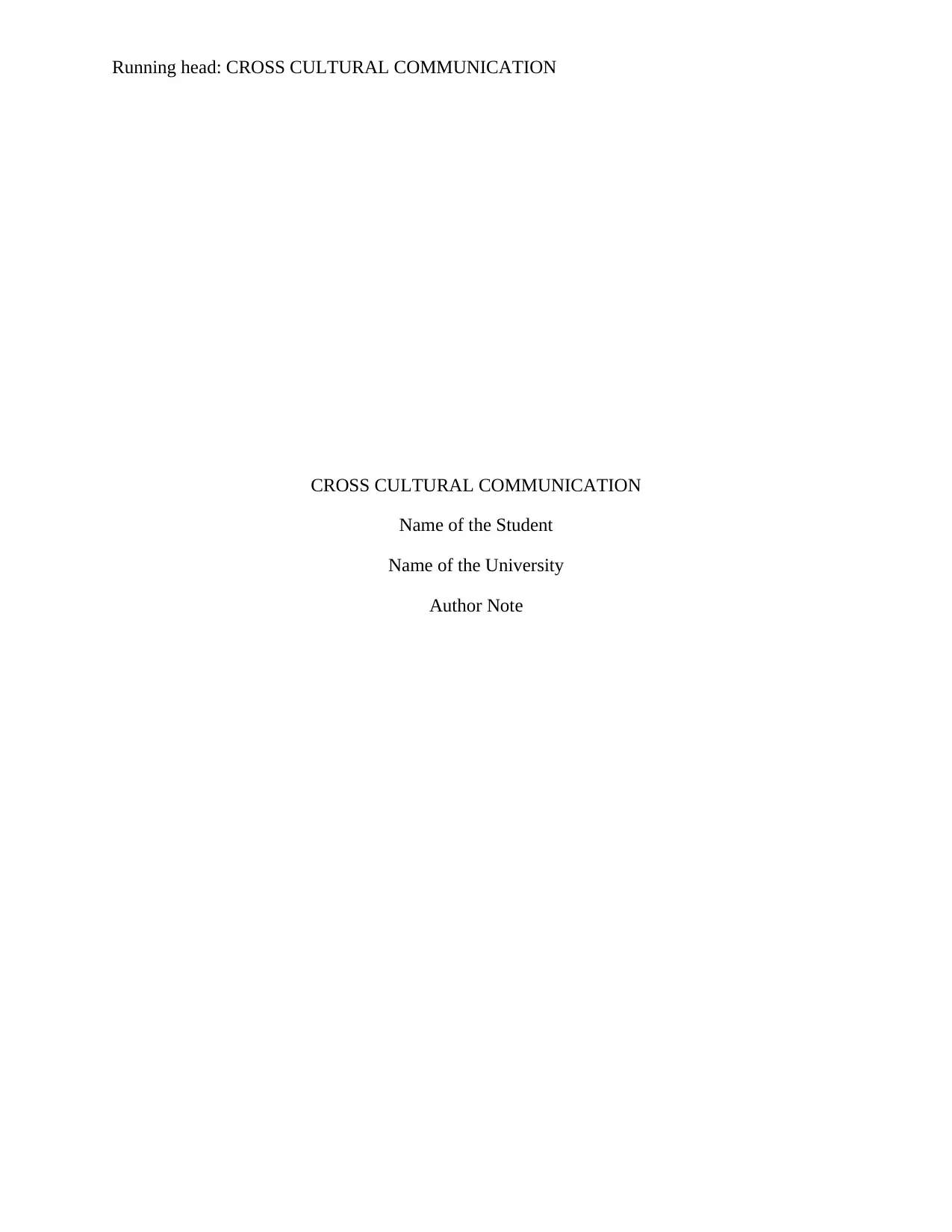
Running head: CROSS CULTURAL COMMUNICATION
CROSS CULTURAL COMMUNICATION
Name of the Student
Name of the University
Author Note
CROSS CULTURAL COMMUNICATION
Name of the Student
Name of the University
Author Note
Paraphrase This Document
Need a fresh take? Get an instant paraphrase of this document with our AI Paraphraser

1CROSS CULTURAL COMMUNICATION
Table of Contents
Answer to Question 1......................................................................................................................2
Answer to Question 2......................................................................................................................3
Answer to Question 3......................................................................................................................4
Answer to Question 4......................................................................................................................5
Answer to Question 5......................................................................................................................6
Answer to Question 6......................................................................................................................6
Answer to Question 7......................................................................................................................7
Answer to Question 8......................................................................................................................8
Answer to Question 9......................................................................................................................9
Answer to Question 10..................................................................................................................10
References......................................................................................................................................11
Table of Contents
Answer to Question 1......................................................................................................................2
Answer to Question 2......................................................................................................................3
Answer to Question 3......................................................................................................................4
Answer to Question 4......................................................................................................................5
Answer to Question 5......................................................................................................................6
Answer to Question 6......................................................................................................................6
Answer to Question 7......................................................................................................................7
Answer to Question 8......................................................................................................................8
Answer to Question 9......................................................................................................................9
Answer to Question 10..................................................................................................................10
References......................................................................................................................................11
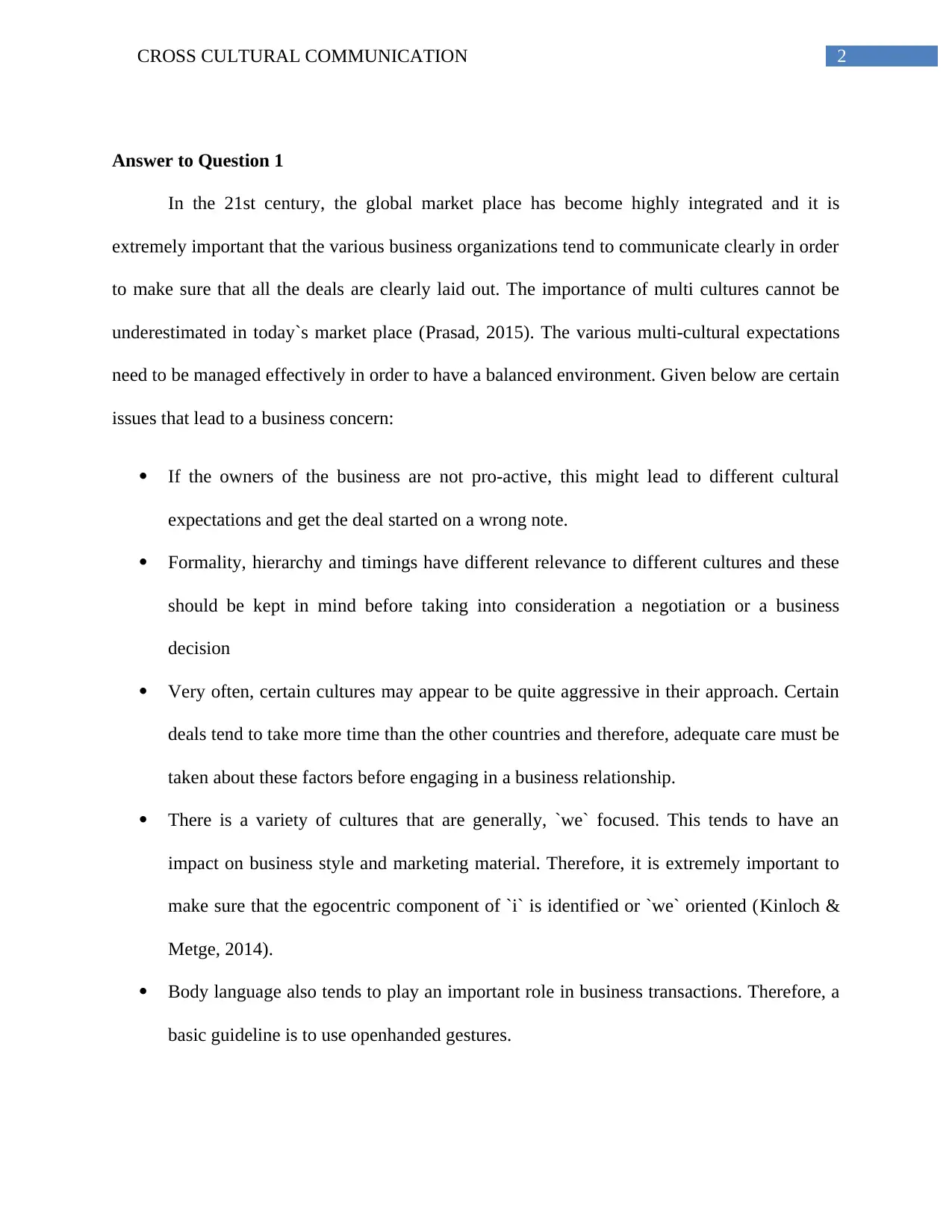
2CROSS CULTURAL COMMUNICATION
Answer to Question 1
In the 21st century, the global market place has become highly integrated and it is
extremely important that the various business organizations tend to communicate clearly in order
to make sure that all the deals are clearly laid out. The importance of multi cultures cannot be
underestimated in today`s market place (Prasad, 2015). The various multi-cultural expectations
need to be managed effectively in order to have a balanced environment. Given below are certain
issues that lead to a business concern:
If the owners of the business are not pro-active, this might lead to different cultural
expectations and get the deal started on a wrong note.
Formality, hierarchy and timings have different relevance to different cultures and these
should be kept in mind before taking into consideration a negotiation or a business
decision
Very often, certain cultures may appear to be quite aggressive in their approach. Certain
deals tend to take more time than the other countries and therefore, adequate care must be
taken about these factors before engaging in a business relationship.
There is a variety of cultures that are generally, `we` focused. This tends to have an
impact on business style and marketing material. Therefore, it is extremely important to
make sure that the egocentric component of `i` is identified or `we` oriented (Kinloch &
Metge, 2014).
Body language also tends to play an important role in business transactions. Therefore, a
basic guideline is to use openhanded gestures.
Answer to Question 1
In the 21st century, the global market place has become highly integrated and it is
extremely important that the various business organizations tend to communicate clearly in order
to make sure that all the deals are clearly laid out. The importance of multi cultures cannot be
underestimated in today`s market place (Prasad, 2015). The various multi-cultural expectations
need to be managed effectively in order to have a balanced environment. Given below are certain
issues that lead to a business concern:
If the owners of the business are not pro-active, this might lead to different cultural
expectations and get the deal started on a wrong note.
Formality, hierarchy and timings have different relevance to different cultures and these
should be kept in mind before taking into consideration a negotiation or a business
decision
Very often, certain cultures may appear to be quite aggressive in their approach. Certain
deals tend to take more time than the other countries and therefore, adequate care must be
taken about these factors before engaging in a business relationship.
There is a variety of cultures that are generally, `we` focused. This tends to have an
impact on business style and marketing material. Therefore, it is extremely important to
make sure that the egocentric component of `i` is identified or `we` oriented (Kinloch &
Metge, 2014).
Body language also tends to play an important role in business transactions. Therefore, a
basic guideline is to use openhanded gestures.
⊘ This is a preview!⊘
Do you want full access?
Subscribe today to unlock all pages.

Trusted by 1+ million students worldwide
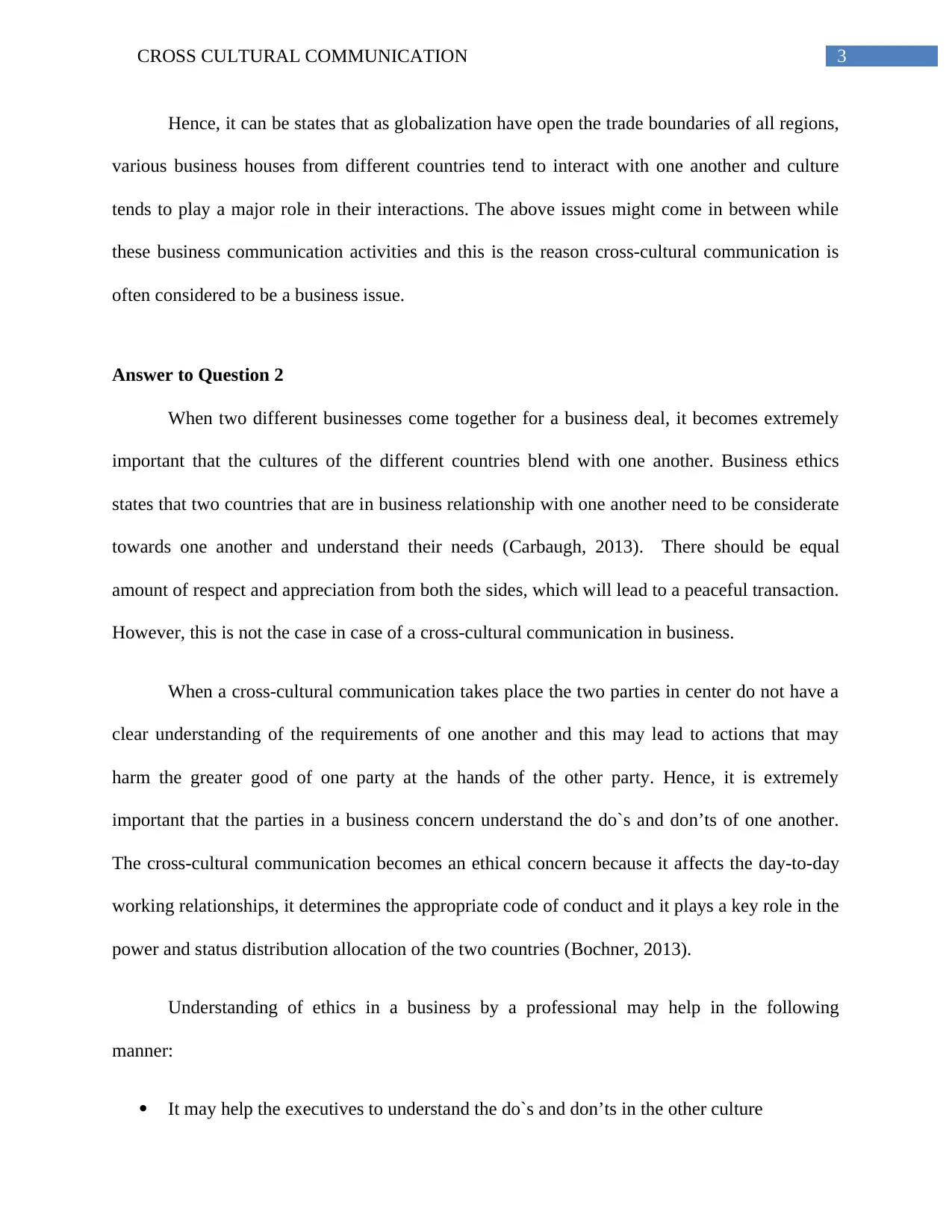
3CROSS CULTURAL COMMUNICATION
Hence, it can be states that as globalization have open the trade boundaries of all regions,
various business houses from different countries tend to interact with one another and culture
tends to play a major role in their interactions. The above issues might come in between while
these business communication activities and this is the reason cross-cultural communication is
often considered to be a business issue.
Answer to Question 2
When two different businesses come together for a business deal, it becomes extremely
important that the cultures of the different countries blend with one another. Business ethics
states that two countries that are in business relationship with one another need to be considerate
towards one another and understand their needs (Carbaugh, 2013). There should be equal
amount of respect and appreciation from both the sides, which will lead to a peaceful transaction.
However, this is not the case in case of a cross-cultural communication in business.
When a cross-cultural communication takes place the two parties in center do not have a
clear understanding of the requirements of one another and this may lead to actions that may
harm the greater good of one party at the hands of the other party. Hence, it is extremely
important that the parties in a business concern understand the do`s and don’ts of one another.
The cross-cultural communication becomes an ethical concern because it affects the day-to-day
working relationships, it determines the appropriate code of conduct and it plays a key role in the
power and status distribution allocation of the two countries (Bochner, 2013).
Understanding of ethics in a business by a professional may help in the following
manner:
It may help the executives to understand the do`s and don’ts in the other culture
Hence, it can be states that as globalization have open the trade boundaries of all regions,
various business houses from different countries tend to interact with one another and culture
tends to play a major role in their interactions. The above issues might come in between while
these business communication activities and this is the reason cross-cultural communication is
often considered to be a business issue.
Answer to Question 2
When two different businesses come together for a business deal, it becomes extremely
important that the cultures of the different countries blend with one another. Business ethics
states that two countries that are in business relationship with one another need to be considerate
towards one another and understand their needs (Carbaugh, 2013). There should be equal
amount of respect and appreciation from both the sides, which will lead to a peaceful transaction.
However, this is not the case in case of a cross-cultural communication in business.
When a cross-cultural communication takes place the two parties in center do not have a
clear understanding of the requirements of one another and this may lead to actions that may
harm the greater good of one party at the hands of the other party. Hence, it is extremely
important that the parties in a business concern understand the do`s and don’ts of one another.
The cross-cultural communication becomes an ethical concern because it affects the day-to-day
working relationships, it determines the appropriate code of conduct and it plays a key role in the
power and status distribution allocation of the two countries (Bochner, 2013).
Understanding of ethics in a business by a professional may help in the following
manner:
It may help the executives to understand the do`s and don’ts in the other culture
Paraphrase This Document
Need a fresh take? Get an instant paraphrase of this document with our AI Paraphraser
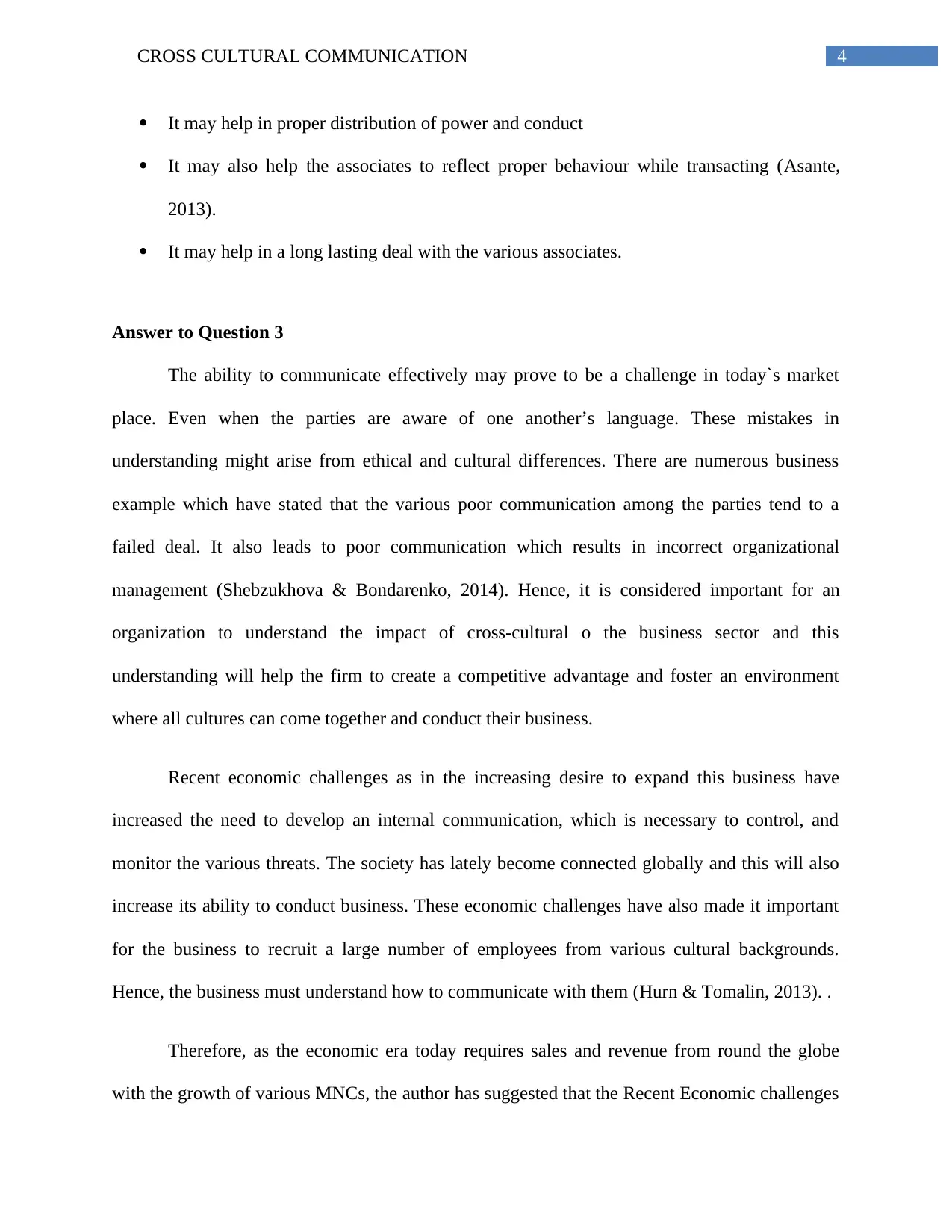
4CROSS CULTURAL COMMUNICATION
It may help in proper distribution of power and conduct
It may also help the associates to reflect proper behaviour while transacting (Asante,
2013).
It may help in a long lasting deal with the various associates.
Answer to Question 3
The ability to communicate effectively may prove to be a challenge in today`s market
place. Even when the parties are aware of one another’s language. These mistakes in
understanding might arise from ethical and cultural differences. There are numerous business
example which have stated that the various poor communication among the parties tend to a
failed deal. It also leads to poor communication which results in incorrect organizational
management (Shebzukhova & Bondarenko, 2014). Hence, it is considered important for an
organization to understand the impact of cross-cultural o the business sector and this
understanding will help the firm to create a competitive advantage and foster an environment
where all cultures can come together and conduct their business.
Recent economic challenges as in the increasing desire to expand this business have
increased the need to develop an internal communication, which is necessary to control, and
monitor the various threats. The society has lately become connected globally and this will also
increase its ability to conduct business. These economic challenges have also made it important
for the business to recruit a large number of employees from various cultural backgrounds.
Hence, the business must understand how to communicate with them (Hurn & Tomalin, 2013). .
Therefore, as the economic era today requires sales and revenue from round the globe
with the growth of various MNCs, the author has suggested that the Recent Economic challenges
It may help in proper distribution of power and conduct
It may also help the associates to reflect proper behaviour while transacting (Asante,
2013).
It may help in a long lasting deal with the various associates.
Answer to Question 3
The ability to communicate effectively may prove to be a challenge in today`s market
place. Even when the parties are aware of one another’s language. These mistakes in
understanding might arise from ethical and cultural differences. There are numerous business
example which have stated that the various poor communication among the parties tend to a
failed deal. It also leads to poor communication which results in incorrect organizational
management (Shebzukhova & Bondarenko, 2014). Hence, it is considered important for an
organization to understand the impact of cross-cultural o the business sector and this
understanding will help the firm to create a competitive advantage and foster an environment
where all cultures can come together and conduct their business.
Recent economic challenges as in the increasing desire to expand this business have
increased the need to develop an internal communication, which is necessary to control, and
monitor the various threats. The society has lately become connected globally and this will also
increase its ability to conduct business. These economic challenges have also made it important
for the business to recruit a large number of employees from various cultural backgrounds.
Hence, the business must understand how to communicate with them (Hurn & Tomalin, 2013). .
Therefore, as the economic era today requires sales and revenue from round the globe
with the growth of various MNCs, the author has suggested that the Recent Economic challenges
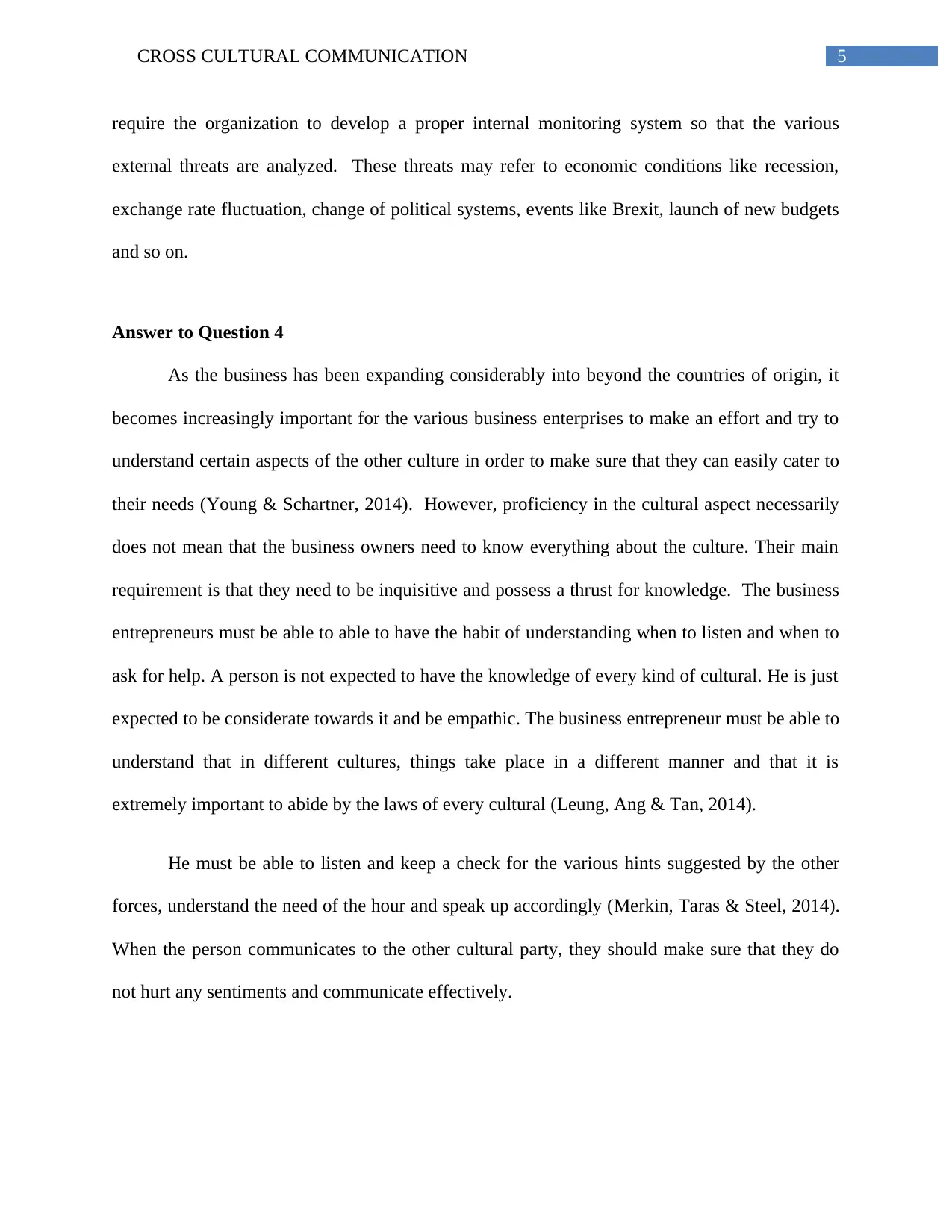
5CROSS CULTURAL COMMUNICATION
require the organization to develop a proper internal monitoring system so that the various
external threats are analyzed. These threats may refer to economic conditions like recession,
exchange rate fluctuation, change of political systems, events like Brexit, launch of new budgets
and so on.
Answer to Question 4
As the business has been expanding considerably into beyond the countries of origin, it
becomes increasingly important for the various business enterprises to make an effort and try to
understand certain aspects of the other culture in order to make sure that they can easily cater to
their needs (Young & Schartner, 2014). However, proficiency in the cultural aspect necessarily
does not mean that the business owners need to know everything about the culture. Their main
requirement is that they need to be inquisitive and possess a thrust for knowledge. The business
entrepreneurs must be able to able to have the habit of understanding when to listen and when to
ask for help. A person is not expected to have the knowledge of every kind of cultural. He is just
expected to be considerate towards it and be empathic. The business entrepreneur must be able to
understand that in different cultures, things take place in a different manner and that it is
extremely important to abide by the laws of every cultural (Leung, Ang & Tan, 2014).
He must be able to listen and keep a check for the various hints suggested by the other
forces, understand the need of the hour and speak up accordingly (Merkin, Taras & Steel, 2014).
When the person communicates to the other cultural party, they should make sure that they do
not hurt any sentiments and communicate effectively.
require the organization to develop a proper internal monitoring system so that the various
external threats are analyzed. These threats may refer to economic conditions like recession,
exchange rate fluctuation, change of political systems, events like Brexit, launch of new budgets
and so on.
Answer to Question 4
As the business has been expanding considerably into beyond the countries of origin, it
becomes increasingly important for the various business enterprises to make an effort and try to
understand certain aspects of the other culture in order to make sure that they can easily cater to
their needs (Young & Schartner, 2014). However, proficiency in the cultural aspect necessarily
does not mean that the business owners need to know everything about the culture. Their main
requirement is that they need to be inquisitive and possess a thrust for knowledge. The business
entrepreneurs must be able to able to have the habit of understanding when to listen and when to
ask for help. A person is not expected to have the knowledge of every kind of cultural. He is just
expected to be considerate towards it and be empathic. The business entrepreneur must be able to
understand that in different cultures, things take place in a different manner and that it is
extremely important to abide by the laws of every cultural (Leung, Ang & Tan, 2014).
He must be able to listen and keep a check for the various hints suggested by the other
forces, understand the need of the hour and speak up accordingly (Merkin, Taras & Steel, 2014).
When the person communicates to the other cultural party, they should make sure that they do
not hurt any sentiments and communicate effectively.
⊘ This is a preview!⊘
Do you want full access?
Subscribe today to unlock all pages.

Trusted by 1+ million students worldwide
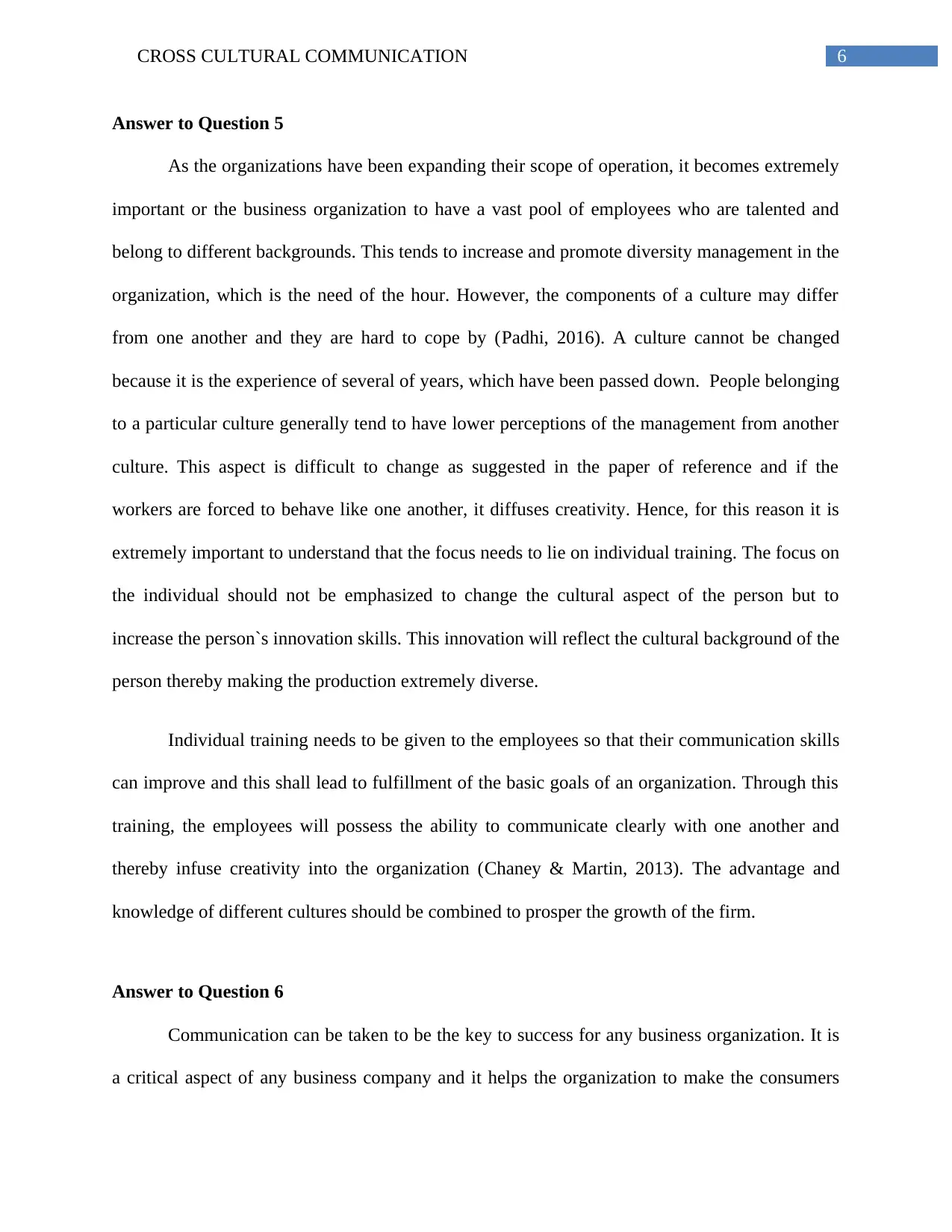
6CROSS CULTURAL COMMUNICATION
Answer to Question 5
As the organizations have been expanding their scope of operation, it becomes extremely
important or the business organization to have a vast pool of employees who are talented and
belong to different backgrounds. This tends to increase and promote diversity management in the
organization, which is the need of the hour. However, the components of a culture may differ
from one another and they are hard to cope by (Padhi, 2016). A culture cannot be changed
because it is the experience of several of years, which have been passed down. People belonging
to a particular culture generally tend to have lower perceptions of the management from another
culture. This aspect is difficult to change as suggested in the paper of reference and if the
workers are forced to behave like one another, it diffuses creativity. Hence, for this reason it is
extremely important to understand that the focus needs to lie on individual training. The focus on
the individual should not be emphasized to change the cultural aspect of the person but to
increase the person`s innovation skills. This innovation will reflect the cultural background of the
person thereby making the production extremely diverse.
Individual training needs to be given to the employees so that their communication skills
can improve and this shall lead to fulfillment of the basic goals of an organization. Through this
training, the employees will possess the ability to communicate clearly with one another and
thereby infuse creativity into the organization (Chaney & Martin, 2013). The advantage and
knowledge of different cultures should be combined to prosper the growth of the firm.
Answer to Question 6
Communication can be taken to be the key to success for any business organization. It is
a critical aspect of any business company and it helps the organization to make the consumers
Answer to Question 5
As the organizations have been expanding their scope of operation, it becomes extremely
important or the business organization to have a vast pool of employees who are talented and
belong to different backgrounds. This tends to increase and promote diversity management in the
organization, which is the need of the hour. However, the components of a culture may differ
from one another and they are hard to cope by (Padhi, 2016). A culture cannot be changed
because it is the experience of several of years, which have been passed down. People belonging
to a particular culture generally tend to have lower perceptions of the management from another
culture. This aspect is difficult to change as suggested in the paper of reference and if the
workers are forced to behave like one another, it diffuses creativity. Hence, for this reason it is
extremely important to understand that the focus needs to lie on individual training. The focus on
the individual should not be emphasized to change the cultural aspect of the person but to
increase the person`s innovation skills. This innovation will reflect the cultural background of the
person thereby making the production extremely diverse.
Individual training needs to be given to the employees so that their communication skills
can improve and this shall lead to fulfillment of the basic goals of an organization. Through this
training, the employees will possess the ability to communicate clearly with one another and
thereby infuse creativity into the organization (Chaney & Martin, 2013). The advantage and
knowledge of different cultures should be combined to prosper the growth of the firm.
Answer to Question 6
Communication can be taken to be the key to success for any business organization. It is
a critical aspect of any business company and it helps the organization to make the consumers
Paraphrase This Document
Need a fresh take? Get an instant paraphrase of this document with our AI Paraphraser
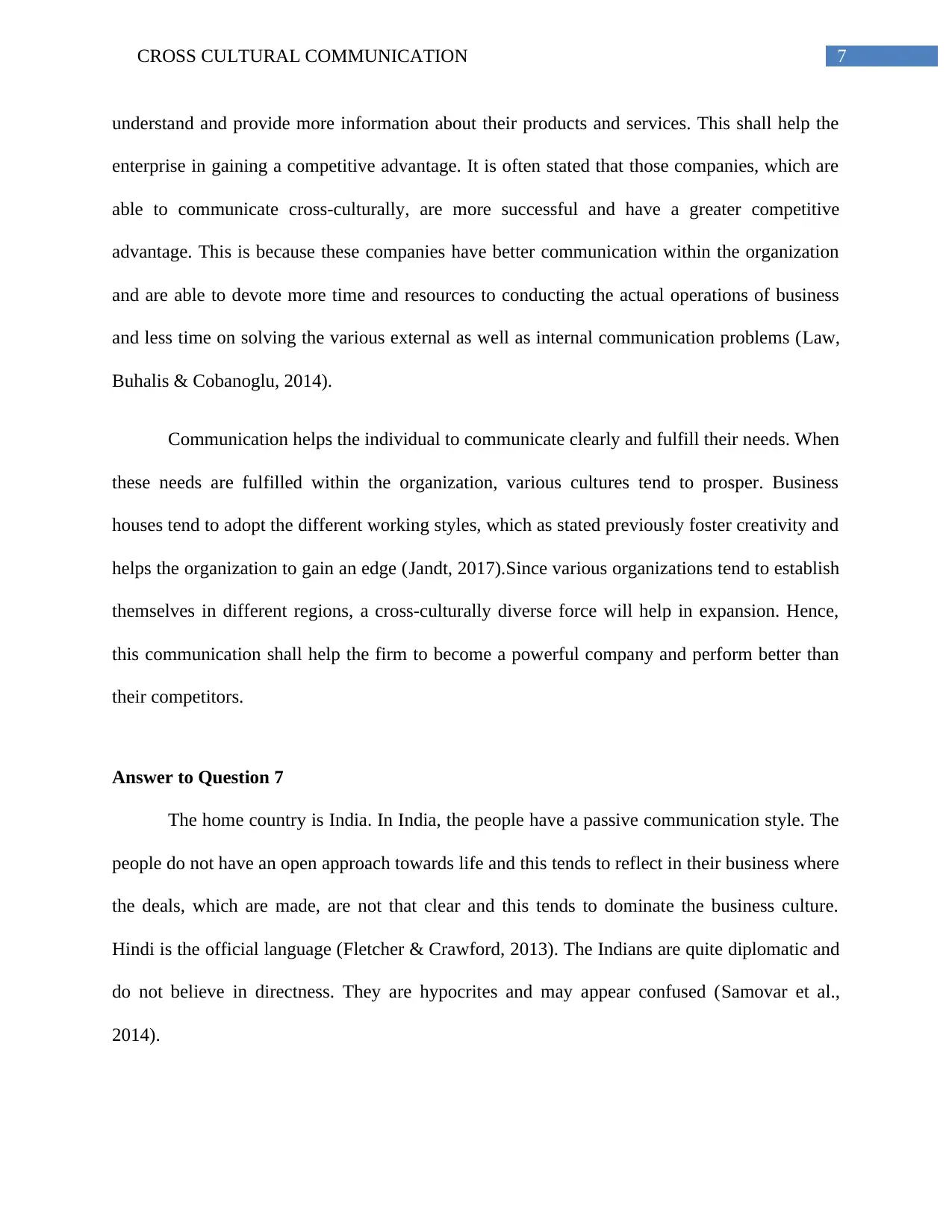
7CROSS CULTURAL COMMUNICATION
understand and provide more information about their products and services. This shall help the
enterprise in gaining a competitive advantage. It is often stated that those companies, which are
able to communicate cross-culturally, are more successful and have a greater competitive
advantage. This is because these companies have better communication within the organization
and are able to devote more time and resources to conducting the actual operations of business
and less time on solving the various external as well as internal communication problems (Law,
Buhalis & Cobanoglu, 2014).
Communication helps the individual to communicate clearly and fulfill their needs. When
these needs are fulfilled within the organization, various cultures tend to prosper. Business
houses tend to adopt the different working styles, which as stated previously foster creativity and
helps the organization to gain an edge (Jandt, 2017).Since various organizations tend to establish
themselves in different regions, a cross-culturally diverse force will help in expansion. Hence,
this communication shall help the firm to become a powerful company and perform better than
their competitors.
Answer to Question 7
The home country is India. In India, the people have a passive communication style. The
people do not have an open approach towards life and this tends to reflect in their business where
the deals, which are made, are not that clear and this tends to dominate the business culture.
Hindi is the official language (Fletcher & Crawford, 2013). The Indians are quite diplomatic and
do not believe in directness. They are hypocrites and may appear confused (Samovar et al.,
2014).
understand and provide more information about their products and services. This shall help the
enterprise in gaining a competitive advantage. It is often stated that those companies, which are
able to communicate cross-culturally, are more successful and have a greater competitive
advantage. This is because these companies have better communication within the organization
and are able to devote more time and resources to conducting the actual operations of business
and less time on solving the various external as well as internal communication problems (Law,
Buhalis & Cobanoglu, 2014).
Communication helps the individual to communicate clearly and fulfill their needs. When
these needs are fulfilled within the organization, various cultures tend to prosper. Business
houses tend to adopt the different working styles, which as stated previously foster creativity and
helps the organization to gain an edge (Jandt, 2017).Since various organizations tend to establish
themselves in different regions, a cross-culturally diverse force will help in expansion. Hence,
this communication shall help the firm to become a powerful company and perform better than
their competitors.
Answer to Question 7
The home country is India. In India, the people have a passive communication style. The
people do not have an open approach towards life and this tends to reflect in their business where
the deals, which are made, are not that clear and this tends to dominate the business culture.
Hindi is the official language (Fletcher & Crawford, 2013). The Indians are quite diplomatic and
do not believe in directness. They are hypocrites and may appear confused (Samovar et al.,
2014).
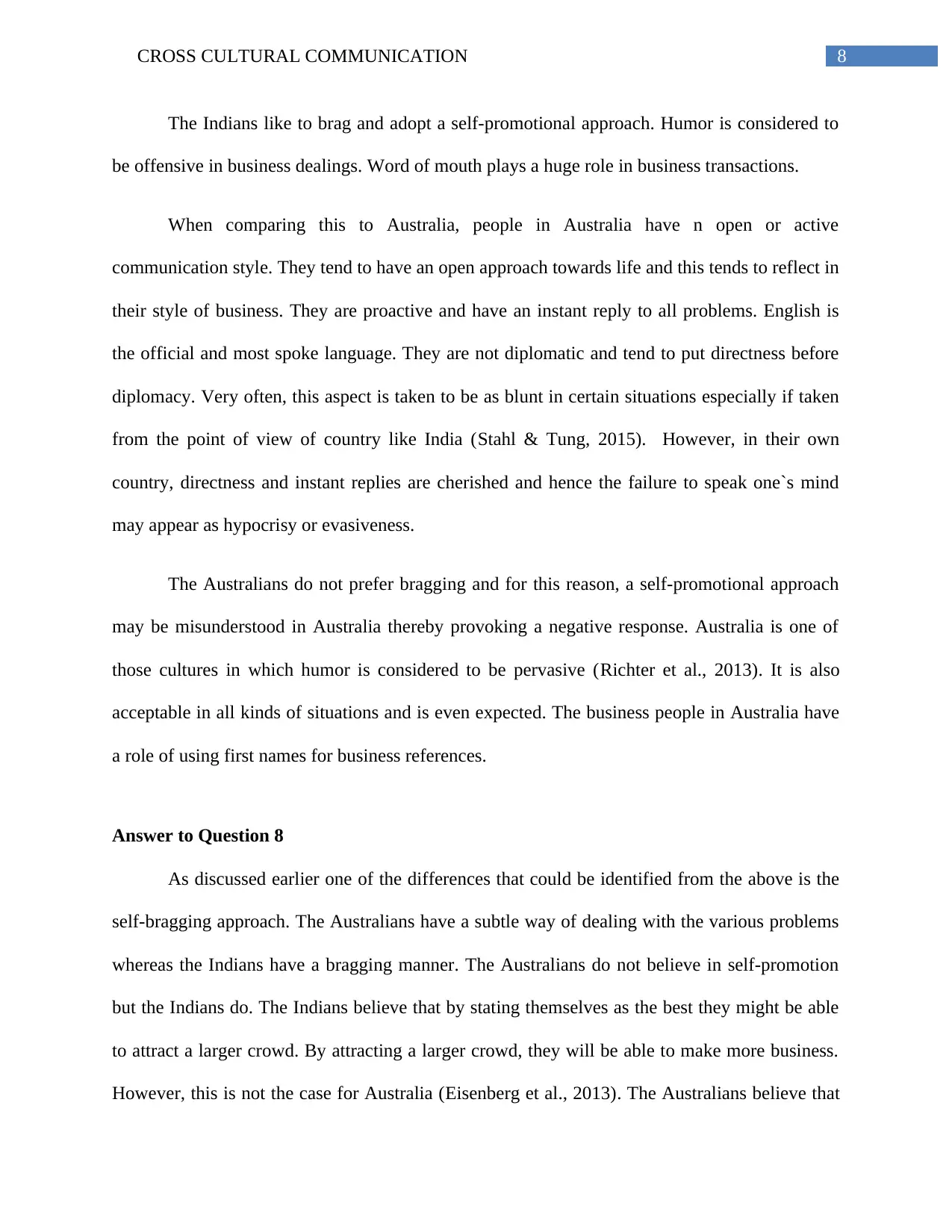
8CROSS CULTURAL COMMUNICATION
The Indians like to brag and adopt a self-promotional approach. Humor is considered to
be offensive in business dealings. Word of mouth plays a huge role in business transactions.
When comparing this to Australia, people in Australia have n open or active
communication style. They tend to have an open approach towards life and this tends to reflect in
their style of business. They are proactive and have an instant reply to all problems. English is
the official and most spoke language. They are not diplomatic and tend to put directness before
diplomacy. Very often, this aspect is taken to be as blunt in certain situations especially if taken
from the point of view of country like India (Stahl & Tung, 2015). However, in their own
country, directness and instant replies are cherished and hence the failure to speak one`s mind
may appear as hypocrisy or evasiveness.
The Australians do not prefer bragging and for this reason, a self-promotional approach
may be misunderstood in Australia thereby provoking a negative response. Australia is one of
those cultures in which humor is considered to be pervasive (Richter et al., 2013). It is also
acceptable in all kinds of situations and is even expected. The business people in Australia have
a role of using first names for business references.
Answer to Question 8
As discussed earlier one of the differences that could be identified from the above is the
self-bragging approach. The Australians have a subtle way of dealing with the various problems
whereas the Indians have a bragging manner. The Australians do not believe in self-promotion
but the Indians do. The Indians believe that by stating themselves as the best they might be able
to attract a larger crowd. By attracting a larger crowd, they will be able to make more business.
However, this is not the case for Australia (Eisenberg et al., 2013). The Australians believe that
The Indians like to brag and adopt a self-promotional approach. Humor is considered to
be offensive in business dealings. Word of mouth plays a huge role in business transactions.
When comparing this to Australia, people in Australia have n open or active
communication style. They tend to have an open approach towards life and this tends to reflect in
their style of business. They are proactive and have an instant reply to all problems. English is
the official and most spoke language. They are not diplomatic and tend to put directness before
diplomacy. Very often, this aspect is taken to be as blunt in certain situations especially if taken
from the point of view of country like India (Stahl & Tung, 2015). However, in their own
country, directness and instant replies are cherished and hence the failure to speak one`s mind
may appear as hypocrisy or evasiveness.
The Australians do not prefer bragging and for this reason, a self-promotional approach
may be misunderstood in Australia thereby provoking a negative response. Australia is one of
those cultures in which humor is considered to be pervasive (Richter et al., 2013). It is also
acceptable in all kinds of situations and is even expected. The business people in Australia have
a role of using first names for business references.
Answer to Question 8
As discussed earlier one of the differences that could be identified from the above is the
self-bragging approach. The Australians have a subtle way of dealing with the various problems
whereas the Indians have a bragging manner. The Australians do not believe in self-promotion
but the Indians do. The Indians believe that by stating themselves as the best they might be able
to attract a larger crowd. By attracting a larger crowd, they will be able to make more business.
However, this is not the case for Australia (Eisenberg et al., 2013). The Australians believe that
⊘ This is a preview!⊘
Do you want full access?
Subscribe today to unlock all pages.

Trusted by 1+ million students worldwide
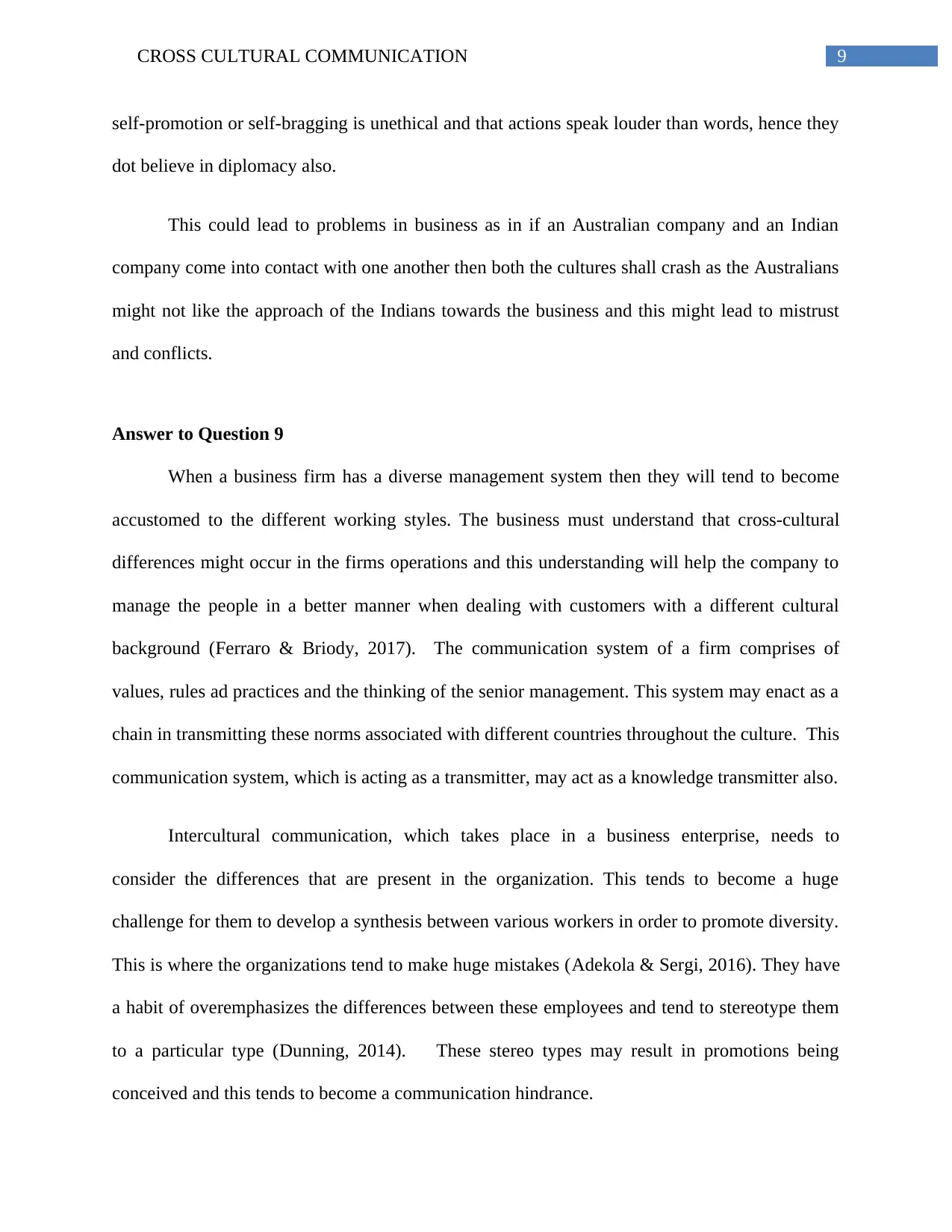
9CROSS CULTURAL COMMUNICATION
self-promotion or self-bragging is unethical and that actions speak louder than words, hence they
dot believe in diplomacy also.
This could lead to problems in business as in if an Australian company and an Indian
company come into contact with one another then both the cultures shall crash as the Australians
might not like the approach of the Indians towards the business and this might lead to mistrust
and conflicts.
Answer to Question 9
When a business firm has a diverse management system then they will tend to become
accustomed to the different working styles. The business must understand that cross-cultural
differences might occur in the firms operations and this understanding will help the company to
manage the people in a better manner when dealing with customers with a different cultural
background (Ferraro & Briody, 2017). The communication system of a firm comprises of
values, rules ad practices and the thinking of the senior management. This system may enact as a
chain in transmitting these norms associated with different countries throughout the culture. This
communication system, which is acting as a transmitter, may act as a knowledge transmitter also.
Intercultural communication, which takes place in a business enterprise, needs to
consider the differences that are present in the organization. This tends to become a huge
challenge for them to develop a synthesis between various workers in order to promote diversity.
This is where the organizations tend to make huge mistakes (Adekola & Sergi, 2016). They have
a habit of overemphasizes the differences between these employees and tend to stereotype them
to a particular type (Dunning, 2014). These stereo types may result in promotions being
conceived and this tends to become a communication hindrance.
self-promotion or self-bragging is unethical and that actions speak louder than words, hence they
dot believe in diplomacy also.
This could lead to problems in business as in if an Australian company and an Indian
company come into contact with one another then both the cultures shall crash as the Australians
might not like the approach of the Indians towards the business and this might lead to mistrust
and conflicts.
Answer to Question 9
When a business firm has a diverse management system then they will tend to become
accustomed to the different working styles. The business must understand that cross-cultural
differences might occur in the firms operations and this understanding will help the company to
manage the people in a better manner when dealing with customers with a different cultural
background (Ferraro & Briody, 2017). The communication system of a firm comprises of
values, rules ad practices and the thinking of the senior management. This system may enact as a
chain in transmitting these norms associated with different countries throughout the culture. This
communication system, which is acting as a transmitter, may act as a knowledge transmitter also.
Intercultural communication, which takes place in a business enterprise, needs to
consider the differences that are present in the organization. This tends to become a huge
challenge for them to develop a synthesis between various workers in order to promote diversity.
This is where the organizations tend to make huge mistakes (Adekola & Sergi, 2016). They have
a habit of overemphasizes the differences between these employees and tend to stereotype them
to a particular type (Dunning, 2014). These stereo types may result in promotions being
conceived and this tends to become a communication hindrance.
Paraphrase This Document
Need a fresh take? Get an instant paraphrase of this document with our AI Paraphraser
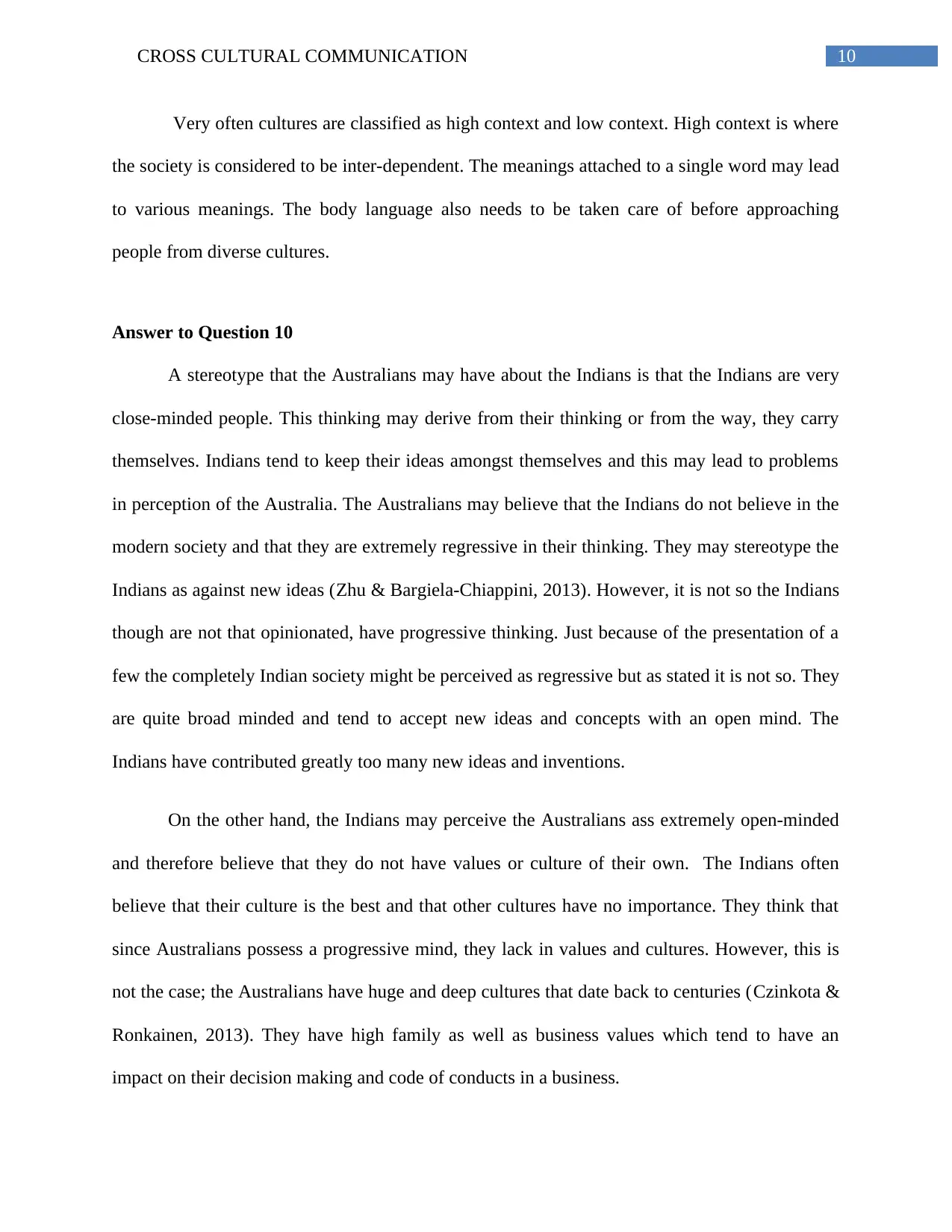
10CROSS CULTURAL COMMUNICATION
Very often cultures are classified as high context and low context. High context is where
the society is considered to be inter-dependent. The meanings attached to a single word may lead
to various meanings. The body language also needs to be taken care of before approaching
people from diverse cultures.
Answer to Question 10
A stereotype that the Australians may have about the Indians is that the Indians are very
close-minded people. This thinking may derive from their thinking or from the way, they carry
themselves. Indians tend to keep their ideas amongst themselves and this may lead to problems
in perception of the Australia. The Australians may believe that the Indians do not believe in the
modern society and that they are extremely regressive in their thinking. They may stereotype the
Indians as against new ideas (Zhu & Bargiela-Chiappini, 2013). However, it is not so the Indians
though are not that opinionated, have progressive thinking. Just because of the presentation of a
few the completely Indian society might be perceived as regressive but as stated it is not so. They
are quite broad minded and tend to accept new ideas and concepts with an open mind. The
Indians have contributed greatly too many new ideas and inventions.
On the other hand, the Indians may perceive the Australians ass extremely open-minded
and therefore believe that they do not have values or culture of their own. The Indians often
believe that their culture is the best and that other cultures have no importance. They think that
since Australians possess a progressive mind, they lack in values and cultures. However, this is
not the case; the Australians have huge and deep cultures that date back to centuries (Czinkota &
Ronkainen, 2013). They have high family as well as business values which tend to have an
impact on their decision making and code of conducts in a business.
Very often cultures are classified as high context and low context. High context is where
the society is considered to be inter-dependent. The meanings attached to a single word may lead
to various meanings. The body language also needs to be taken care of before approaching
people from diverse cultures.
Answer to Question 10
A stereotype that the Australians may have about the Indians is that the Indians are very
close-minded people. This thinking may derive from their thinking or from the way, they carry
themselves. Indians tend to keep their ideas amongst themselves and this may lead to problems
in perception of the Australia. The Australians may believe that the Indians do not believe in the
modern society and that they are extremely regressive in their thinking. They may stereotype the
Indians as against new ideas (Zhu & Bargiela-Chiappini, 2013). However, it is not so the Indians
though are not that opinionated, have progressive thinking. Just because of the presentation of a
few the completely Indian society might be perceived as regressive but as stated it is not so. They
are quite broad minded and tend to accept new ideas and concepts with an open mind. The
Indians have contributed greatly too many new ideas and inventions.
On the other hand, the Indians may perceive the Australians ass extremely open-minded
and therefore believe that they do not have values or culture of their own. The Indians often
believe that their culture is the best and that other cultures have no importance. They think that
since Australians possess a progressive mind, they lack in values and cultures. However, this is
not the case; the Australians have huge and deep cultures that date back to centuries (Czinkota &
Ronkainen, 2013). They have high family as well as business values which tend to have an
impact on their decision making and code of conducts in a business.
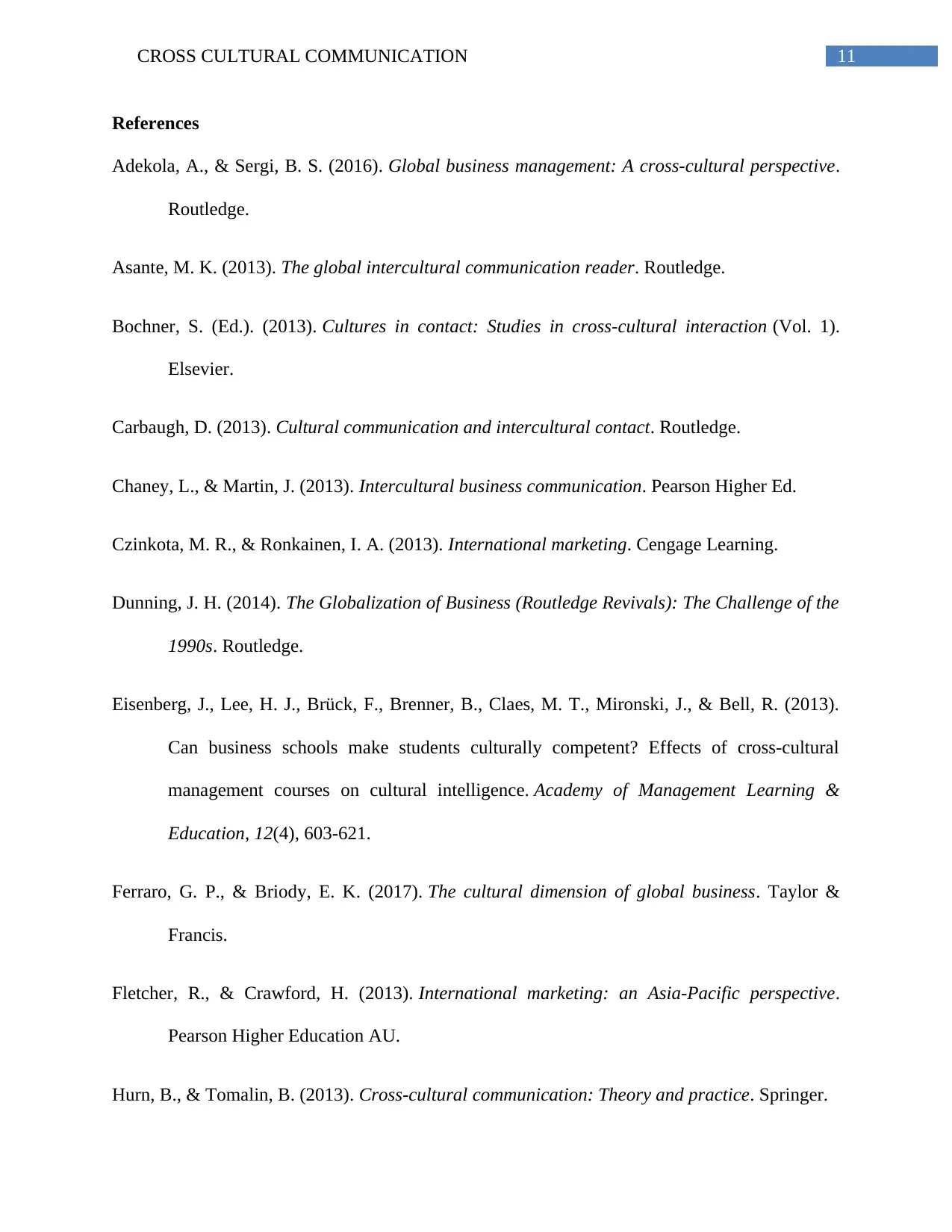
11CROSS CULTURAL COMMUNICATION
References
Adekola, A., & Sergi, B. S. (2016). Global business management: A cross-cultural perspective.
Routledge.
Asante, M. K. (2013). The global intercultural communication reader. Routledge.
Bochner, S. (Ed.). (2013). Cultures in contact: Studies in cross-cultural interaction (Vol. 1).
Elsevier.
Carbaugh, D. (2013). Cultural communication and intercultural contact. Routledge.
Chaney, L., & Martin, J. (2013). Intercultural business communication. Pearson Higher Ed.
Czinkota, M. R., & Ronkainen, I. A. (2013). International marketing. Cengage Learning.
Dunning, J. H. (2014). The Globalization of Business (Routledge Revivals): The Challenge of the
1990s. Routledge.
Eisenberg, J., Lee, H. J., Brück, F., Brenner, B., Claes, M. T., Mironski, J., & Bell, R. (2013).
Can business schools make students culturally competent? Effects of cross-cultural
management courses on cultural intelligence. Academy of Management Learning &
Education, 12(4), 603-621.
Ferraro, G. P., & Briody, E. K. (2017). The cultural dimension of global business. Taylor &
Francis.
Fletcher, R., & Crawford, H. (2013). International marketing: an Asia-Pacific perspective.
Pearson Higher Education AU.
Hurn, B., & Tomalin, B. (2013). Cross-cultural communication: Theory and practice. Springer.
References
Adekola, A., & Sergi, B. S. (2016). Global business management: A cross-cultural perspective.
Routledge.
Asante, M. K. (2013). The global intercultural communication reader. Routledge.
Bochner, S. (Ed.). (2013). Cultures in contact: Studies in cross-cultural interaction (Vol. 1).
Elsevier.
Carbaugh, D. (2013). Cultural communication and intercultural contact. Routledge.
Chaney, L., & Martin, J. (2013). Intercultural business communication. Pearson Higher Ed.
Czinkota, M. R., & Ronkainen, I. A. (2013). International marketing. Cengage Learning.
Dunning, J. H. (2014). The Globalization of Business (Routledge Revivals): The Challenge of the
1990s. Routledge.
Eisenberg, J., Lee, H. J., Brück, F., Brenner, B., Claes, M. T., Mironski, J., & Bell, R. (2013).
Can business schools make students culturally competent? Effects of cross-cultural
management courses on cultural intelligence. Academy of Management Learning &
Education, 12(4), 603-621.
Ferraro, G. P., & Briody, E. K. (2017). The cultural dimension of global business. Taylor &
Francis.
Fletcher, R., & Crawford, H. (2013). International marketing: an Asia-Pacific perspective.
Pearson Higher Education AU.
Hurn, B., & Tomalin, B. (2013). Cross-cultural communication: Theory and practice. Springer.
⊘ This is a preview!⊘
Do you want full access?
Subscribe today to unlock all pages.

Trusted by 1+ million students worldwide
1 out of 14
Related Documents
Your All-in-One AI-Powered Toolkit for Academic Success.
+13062052269
info@desklib.com
Available 24*7 on WhatsApp / Email
![[object Object]](/_next/static/media/star-bottom.7253800d.svg)
Unlock your academic potential
Copyright © 2020–2025 A2Z Services. All Rights Reserved. Developed and managed by ZUCOL.




